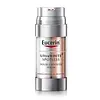What's inside
What's inside
 Key Ingredients
Key Ingredients

 Benefits
Benefits

 Concerns
Concerns

 Ingredients Side-by-side
Ingredients Side-by-side

Water
Skin ConditioningAlcohol Denat.
AntimicrobialButylene Glycol
HumectantGlycerin
HumectantOctocrylene
UV AbsorberIsopropyl Palmitate
EmollientCetearyl Isononanoate
EmollientDistarch Phosphate
AbsorbentMethylpropanediol
SolventIsobutylamido Thiazolyl Resorcinol
BleachingSodium Ascorbyl Phosphate
AntioxidantSodium Hyaluronate
HumectantGlycyrrhiza Inflata Root Extract
Skin ConditioningTocopherol
AntioxidantGlucosylrutin
AntioxidantSodium Stearoyl Glutamate
CleansingGlyceryl Stearate
EmollientSodium Polyacrylate
AbsorbentDimethicone
EmollientIsoquercitrin
AntioxidantCitric Acid
BufferingSodium Chloride
MaskingTrisodium EDTA
Caprylyl Glycol
EmollientPhenoxyethanol
PreservativeParfum
MaskingWater, Alcohol Denat., Butylene Glycol, Glycerin, Octocrylene, Isopropyl Palmitate, Cetearyl Isononanoate, Distarch Phosphate, Methylpropanediol, Isobutylamido Thiazolyl Resorcinol, Sodium Ascorbyl Phosphate, Sodium Hyaluronate, Glycyrrhiza Inflata Root Extract, Tocopherol, Glucosylrutin, Sodium Stearoyl Glutamate, Glyceryl Stearate, Sodium Polyacrylate, Dimethicone, Isoquercitrin, Citric Acid, Sodium Chloride, Trisodium EDTA, Caprylyl Glycol, Phenoxyethanol, Parfum
Water
Skin ConditioningAlcohol Denat.
AntimicrobialHydroxyethylpiperazine Ethane Sulfonic Acid
BufferingGlycolic Acid
BufferingDiisopropyl Adipate
EmollientPropylene Glycol
HumectantPentylene Glycol
Skin ConditioningCitric Acid
BufferingPPG-26-Buteth-26
Skin ConditioningPEG-30 Glyceryl Cocoate
EmulsifyingPEG-40 Hydrogenated Castor Oil
EmulsifyingSodium Hydroxide
BufferingP-Anisic Acid
MaskingCapryloyl Salicylic Acid
ExfoliatingTetrasodium EDTA
Polyquaternium-10
Water, Alcohol Denat., Hydroxyethylpiperazine Ethane Sulfonic Acid, Glycolic Acid, Diisopropyl Adipate, Propylene Glycol, Pentylene Glycol, Citric Acid, PPG-26-Buteth-26, PEG-30 Glyceryl Cocoate, PEG-40 Hydrogenated Castor Oil, Sodium Hydroxide, P-Anisic Acid, Capryloyl Salicylic Acid, Tetrasodium EDTA, Polyquaternium-10
Ingredients Explained
These ingredients are found in both products.
Ingredients higher up in an ingredient list are typically present in a larger amount.
Alcohol Denat. is an alcohol with a denaturant property. It is created by mixing ethanol with other additives.
This ingredient gets a bad rep because it is irritating and drying - mostly due to its astringent property. Astringents draw out natural oils in tissue, constricting pores and leaving your skin dried out.
However, alcohol denat. is not all that bad.
Due to its low molecular weight, alcohol denat. tends to evaporate quickly. One study on pig skin found half of applied alcohol evaporated in 10 seconds and less than 3% stayed on skin.
This also helps other ingredients become better absorbed upon application.
Studies are conflicted about whether this ingredient causes skin dehydration. One study from 2005 found adding emollients to propanol-based sanitizer decreased skin dryness and irritation. Another study found irritation only occurs if your skin is already damaged.
Small amounts of alcohol are generally tolerated by oily skin or people who live in humid environments.
The rule of thumb is if this alcohol is near the end of an ingredients list, it will probably not affect your skin much.
Also...
This ingredient has antimicrobial and solvent properties.
The antimicrobial property helps preserve products and increase their shelf life. As a solvent, it helps dissolve other ingredients.
Other types of astringent alcohols include:
Learn more about Alcohol Denat.Citric Acid is an alpha hydroxy acid (AHA) naturally found in citrus fruits like oranges, lemons, and limes.
Like other AHAs, citric acid can exfoliate skin by breaking down the bonds that hold dead skin cells together. This helps reveal smoother and brighter skin underneath.
However, this exfoliating effect only happens at high concentrations (20%) which can be hard to find in cosmetic products.
Due to this, citric acid is usually included in small amounts as a pH adjuster. This helps keep products slightly more acidic and compatible with skin's natural pH.
In skincare formulas, citric acid can:
While it can provide some skin benefits, research shows lactic acid and glycolic acid are generally more effective and less irritating exfoliants.
Most citric acid used in skincare today is made by fermenting sugars (usually from molasses). This synthetic version is identical to the natural citrus form but easier to stabilize and use in formulations.
Read more about some other popular AHA's here:
Learn more about Citric AcidWater. It's the most common cosmetic ingredient of all. You'll usually see it at the top of ingredient lists, meaning that it makes up the largest part of the product.
So why is it so popular? Water most often acts as a solvent - this means that it helps dissolve other ingredients into the formulation.
You'll also recognize water as that liquid we all need to stay alive. If you see this, drink a glass of water. Stay hydrated!
Learn more about Water